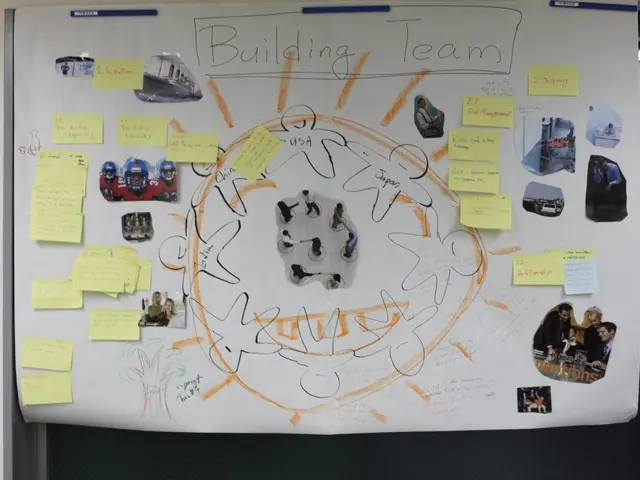A Comprehensive Handbook for Crafting Cutting-Edge Life Science Research Centers
Life science construction is evolving, with a growing emphasis on sustainability and modular design. These innovations are transforming the industry, reducing environmental impact, shortening construction timelines, and enhancing flexibility for evolving scientific needs.
Risk management in life science construction is meticulous, involving change control protocols, creating containment zones, establishing material tracking systems, developing contingency plans for equipment delivery delays, and documenting quality control checkpoints. However, the focus is now shifting towards more sustainable practices.
Sustainable building practices in life science facilities include implementing smart HVAC systems, solar panels, water recycling systems, low-emission building materials, and biophilic design elements. These practices lead to a significant reduction in energy efficiency (25-40%), an 80% recycling rate for water conservation, and a 50% reduction in carbon footprint.
Advanced tools such as Building Information Modeling (BIM) and digital platforms allow precise evaluation of materials for sustainability criteria, ensuring compliance with standards like LEED or BREEAM and optimizing designs to reduce carbon footprints.
Modular and prefabricated construction methods offer numerous advantages in life science facilities. They enable higher quality control, reduce material waste and energy usage during the build phase, and minimise onsite disruption. These approaches shorten project schedules, a critical factor in the fast-moving life sciences sector, and allow for flexible expansion or reconfiguration of specialized lab and manufacturing spaces as technology and research needs evolve.
Modern life science construction designs incorporate modular cleanroom systems, universal equipment connections, overhead service carriers, mobile laboratory benches, and expandable mechanical systems. Real-time environmental monitoring systems are also implemented to ensure optimal conditions.
Critical timeline factors in life science construction projects include design development (4-6 months), regulatory approvals (2-3 months), construction phase (12-18 months), commissioning (3-4 months), and validation (2-3 months). Pressure cascade mapping every 48 hours during construction is performed to maintain safety and efficiency.
Particle count tests at three stages (at-rest, operational, dynamic) are conducted to ensure a clean and sterile environment. Documentation of material certifications and installation procedures is carried out to maintain transparency and accountability. BMS controls with 24/7 monitoring capabilities are implemented to manage energy usage and maintain optimal conditions. Surface cleanliness is tested using ATP monitoring systems.
In summary, the integration of sustainable technologies with modular construction in life sciences leads to greener, faster, and more flexible industrial buildings that better meet environmental goals and operational demands. These advancements are crucial in positioning the life science industry at the forefront of sustainable development, while ensuring technical and economic viability over the project lifespan.
[1] Building Information Modeling (BIM) and its role in sustainable design. (n.d.). Retrieved from https://www.arcadis.com/uk/insights/blog/building-information-modeling-bim-and-its-role-in-sustainable-design
[2] The role of modular construction in sustainable life science facilities. (n.d.). Retrieved from https://www.modularspace.com/insights/role-modular-construction-sustainable-life-science-facilities
[3] Sustainable design for life science facilities: A comprehensive guide. (n.d.). Retrieved from https://www.m Moser.com/perspectives/sustainable-design-life-science-facilities-comprehensive-guide
[4] The benefits of modular construction for life science facilities. (n.d.). Retrieved from https://www.modularspace.com/insights/benefits-modular-construction-life-science-facilities
[5] Exploring the potential of mass timber in life science construction. (n.d.). Retrieved from https://www.archdaily.com/935998/exploring-the-potential-of-mass-timber-in-life-science-construction
- The utilization of Building Information Modeling (BIM) in sustainable design is paramount, as it ensures compliance with environmental standards like LEED or BREEAM, optimizes designs for reduced carbon footprints, and aids in the evaluation of materials for sustainability criteria.
- Life science facilities can significantly benefit from modular and prefabricated construction methods, as they promote higher quality control, minimize material waste and energy usage, reduce construction timelines, and provide flexibility for expanding or reconfiguring specialized lab and manufacturing spaces as techno-innovations and medical-conditions evolve.
- Integrating sustainable building practices, such as smart HVAC systems, solar panels, water recycling systems, low-emission materials, and biophilic design elements, into life science construction designs contributes to a 25-40% energy savings, 80% water recycling rate, and a 50% reduction in carbon footprint – aligning with the health-and-wellness movement and supporting the industry's commitment to sustainable development.




